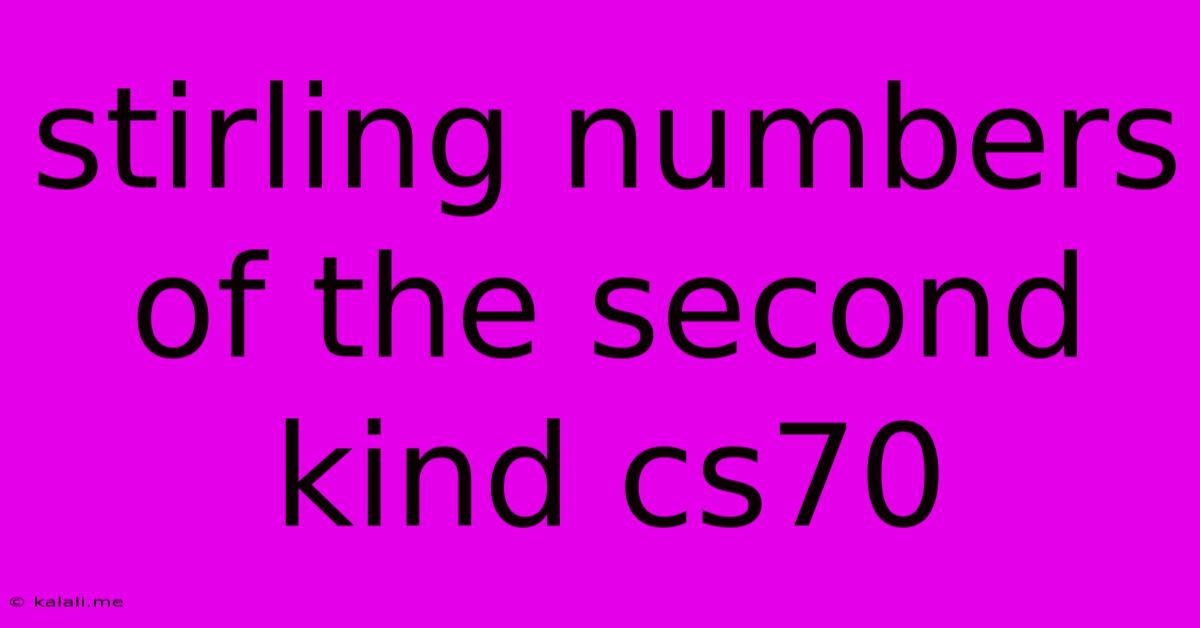Stirling Numbers Of The Second Kind Cs70
Kalali
Jun 07, 2025 · 3 min read

Table of Contents
Stirling Numbers of the Second Kind: A CS70 Perspective
Stirling numbers of the second kind, a fascinating topic often encountered in combinatorics and probability courses like CS70, represent the number of ways to partition a set of n objects into k non-empty subsets. Understanding these numbers is crucial for solving various counting problems and lays the foundation for more advanced concepts in discrete mathematics. This article provides a comprehensive overview, focusing on the intuition, formulas, and applications relevant to a CS70 context.
What are Stirling Numbers of the Second Kind?
Imagine you have n distinct items and you want to divide them into k non-empty groups. The number of ways to do this is given by the Stirling number of the second kind, denoted as S(n, k) or {<sup>n</sup><sub>k</sub>}. The key here is that the groups are unordered (the order of the groups doesn't matter) and each group must contain at least one item.
For example:
- S(3, 2) = 3. If you have three items {A, B, C}, you can partition them into two non-empty subsets in three ways: {{A}, {B, C}}, {{B}, {A, C}}, {{C}, {A, B}}.
- S(4, 2) = 7. The possibilities for partitioning four items into two groups are significantly more numerous.
Formulas and Recurrence Relations
Several methods exist to calculate Stirling numbers of the second kind. The most common are:
-
Recursive Formula: This formula elegantly captures the combinatorial nature of the problem:
S(n, k) = k * S(n-1, k) + S(n-1, k-1)
This formula reflects the two ways to add the nth item: either add it to one of the existing k groups (k * S(n-1, k)) or create a new group containing only the nth item (S(n-1, k-1)).
-
Explicit Formula: A less intuitive but computationally efficient formula is given by:
S(n, k) = (1/k!) * Σ<sub>j=0</sub><sup>k</sup> (-1)<sup>k-j</sup> * (<sup>k</sup><sub>j</sub>) * j<sup>n</sup>
where (<sup>k</sup><sub>j</sub>) represents the binomial coefficient "k choose j." This formula utilizes the principle of inclusion-exclusion.
-
Generating Function: Stirling numbers also have a powerful generating function:
Σ<sub>k=0</sub><sup>n</sup> S(n, k) * x<sup>k</sup> = x<sup>(n)</sup> where x<sup>(n)</sup> is the rising factorial.
Applications in CS70 and Beyond
Stirling numbers of the second kind appear in various areas relevant to a computer science curriculum, including:
- Probability: Calculating probabilities involving partitions and distributions. For example, finding the probability of a specific grouping when randomly assigning items to groups.
- Algorithm Analysis: Analyzing the complexity of algorithms that involve partitioning or grouping elements.
- Combinatorics: Solving counting problems related to set partitions and arrangements.
- Data Structures: Understanding the number of ways to structure data into different groups or clusters.
Example Problem (CS70 Style):
Let's say you have a hash table with n slots and you insert k items independently and uniformly at random. What's the probability that no two items collide (hash to the same slot)? This problem can be solved using Stirling numbers of the second kind, though it requires additional steps to incorporate the probabilities associated with the random hashing process.
Conclusion:
Stirling numbers of the second kind are powerful tools for solving a range of combinatorial problems. Understanding their recursive formula, explicit formula, and applications will significantly enhance your problem-solving abilities in a discrete mathematics context, particularly within the framework of a course like CS70. They provide a fundamental building block for many more advanced concepts in computer science and mathematics. Remember to practice applying these formulas to various problems to solidify your understanding.
Latest Posts
Latest Posts
-
Can God Be The One Above All
Jun 07, 2025
-
Sudo Apt Get Install Xinetd Tftpd Tftp
Jun 07, 2025
-
Cannot Execute Required File Not Found Linux
Jun 07, 2025
-
How Do You Write Song Lyrics In An Essay
Jun 07, 2025
-
What Does It Mean When Someone Age Is M
Jun 07, 2025
Related Post
Thank you for visiting our website which covers about Stirling Numbers Of The Second Kind Cs70 . We hope the information provided has been useful to you. Feel free to contact us if you have any questions or need further assistance. See you next time and don't miss to bookmark.